Changwang Zhang
SAGE: Strategy-Adaptive Generation Engine for Query Rewriting
Jun 24, 2025Abstract:Query rewriting is pivotal for enhancing dense retrieval, yet current methods demand large-scale supervised data or suffer from inefficient reinforcement learning (RL) exploration. In this work, we first establish that guiding Large Language Models (LLMs) with a concise set of expert-crafted strategies, such as semantic expansion and entity disambiguation, substantially improves retrieval effectiveness on challenging benchmarks, including HotpotQA, FEVER, NFCorpus, and SciFact. Building on this insight, we introduce the Strategy-Adaptive Generation Engine (SAGE), which operationalizes these strategies in an RL framework. SAGE introduces two novel reward shaping mechanisms-Strategic Credit Shaping (SCS) and Contrastive Reward Shaping (CRS)-to deliver more informative learning signals. This strategy-guided approach not only achieves new state-of-the-art NDCG@10 results, but also uncovers a compelling emergent behavior: the agent learns to select optimal strategies, reduces unnecessary exploration, and generates concise rewrites, lowering inference cost without sacrificing performance. Our findings demonstrate that strategy-guided RL, enhanced with nuanced reward shaping, offers a scalable, efficient, and more interpretable paradigm for developing the next generation of robust information retrieval systems.
Scaling Test-time Compute for LLM Agents
Jun 15, 2025Abstract:Scaling test time compute has shown remarkable success in improving the reasoning abilities of large language models (LLMs). In this work, we conduct the first systematic exploration of applying test-time scaling methods to language agents and investigate the extent to which it improves their effectiveness. Specifically, we explore different test-time scaling strategies, including: (1) parallel sampling algorithms; (2) sequential revision strategies; (3) verifiers and merging methods; (4)strategies for diversifying rollouts.We carefully analyze and ablate the impact of different design strategies on applying test-time scaling on language agents, and have follow findings: 1. Scaling test time compute could improve the performance of agents. 2. Knowing when to reflect is important for agents. 3. Among different verification and result merging approaches, the list-wise method performs best. 4. Increasing diversified rollouts exerts a positive effect on the agent's task performance.
TaskCraft: Automated Generation of Agentic Tasks
Jun 11, 2025Abstract:Agentic tasks, which require multi-step problem solving with autonomy, tool use, and adaptive reasoning, are becoming increasingly central to the advancement of NLP and AI. However, existing instruction data lacks tool interaction, and current agentic benchmarks rely on costly human annotation, limiting their scalability. We introduce \textsc{TaskCraft}, an automated workflow for generating difficulty-scalable, multi-tool, and verifiable agentic tasks with execution trajectories. TaskCraft expands atomic tasks using depth-based and width-based extensions to create structurally and hierarchically complex challenges. Empirical results show that these tasks improve prompt optimization in the generation workflow and enhance supervised fine-tuning of agentic foundation models. We present a large-scale synthetic dataset of approximately 36,000 tasks with varying difficulty to support future research on agent tuning and evaluation.
Bridging the Gap: Self-Optimized Fine-Tuning for LLM-based Recommender Systems
May 27, 2025Abstract:Recent years have witnessed extensive exploration of Large Language Models (LLMs) on the field of Recommender Systems (RS). There are currently two commonly used strategies to enable LLMs to have recommendation capabilities: 1) The "Guidance-Only" strategy uses in-context learning to exploit and amplify the inherent semantic understanding and item recommendation capabilities of LLMs; 2) The "Tuning-Only" strategy uses supervised fine-tuning (SFT) to fine-tune LLMs with the aim of fitting them to real recommendation data. However, neither of these strategies can effectively bridge the gap between the knowledge space of LLMs and recommendation, and their performance do not meet our expectations. To better enable LLMs to learn recommendation knowledge, we combine the advantages of the above two strategies and proposed a novel "Guidance+Tuning" method called Self-Optimized Fine-Tuning (SOFT), which adopts the idea of curriculum learning. It first employs self-distillation to construct an auxiliary easy-to-learn but meaningful dataset from a fine-tuned LLM. Then it further utilizes a self-adaptive curriculum scheduler to enable LLMs to gradually learn from simpler data (self-distilled data) to more challenging data (real RS data). Extensive experiments demonstrate that SOFT significantly enhances the recommendation accuracy (37.59\% on average) of LLM-based methods. The code is available via https://anonymous.4open.science/r/Self-Optimized-Fine-Tuning-264E
Field Matters: A lightweight LLM-enhanced Method for CTR Prediction
May 20, 2025Abstract:Click-through rate (CTR) prediction is a fundamental task in modern recommender systems. In recent years, the integration of large language models (LLMs) has been shown to effectively enhance the performance of traditional CTR methods. However, existing LLM-enhanced methods often require extensive processing of detailed textual descriptions for large-scale instances or user/item entities, leading to substantial computational overhead. To address this challenge, this work introduces LLaCTR, a novel and lightweight LLM-enhanced CTR method that employs a field-level enhancement paradigm. Specifically, LLaCTR first utilizes LLMs to distill crucial and lightweight semantic knowledge from small-scale feature fields through self-supervised field-feature fine-tuning. Subsequently, it leverages this field-level semantic knowledge to enhance both feature representation and feature interactions. In our experiments, we integrate LLaCTR with six representative CTR models across four datasets, demonstrating its superior performance in terms of both effectiveness and efficiency compared to existing LLM-enhanced methods. Our code is available at https://anonymous.4open.science/r/LLaCTR-EC46.
MSL: Not All Tokens Are What You Need for Tuning LLM as a Recommender
Apr 05, 2025Abstract:Large language models (LLMs), known for their comprehension capabilities and extensive knowledge, have been increasingly applied to recommendation systems (RS). Given the fundamental gap between the mechanism of LLMs and the requirement of RS, researchers have focused on fine-tuning LLMs with recommendation-specific data to enhance their performance. Language Modeling Loss (LML), originally designed for language generation tasks, is commonly adopted. However, we identify two critical limitations of LML: 1) it exhibits significant divergence from the recommendation objective; 2) it erroneously treats all fictitious item descriptions as negative samples, introducing misleading training signals. To address these limitations, we propose a novel Masked Softmax Loss (MSL) tailored for fine-tuning LLMs on recommendation. MSL improves LML by identifying and masking invalid tokens that could lead to fictitious item descriptions during loss computation. This strategy can effectively avoid the interference from erroneous negative signals and ensure well alignment with the recommendation objective supported by theoretical guarantees. During implementation, we identify a potential challenge related to gradient vanishing of MSL. To overcome this, we further introduce the temperature coefficient and propose an Adaptive Temperature Strategy (ATS) that adaptively adjusts the temperature without requiring extensive hyperparameter tuning. Extensive experiments conducted on four public datasets further validate the effectiveness of MSL, achieving an average improvement of 42.24% in NDCG@10. The code is available at https://github.com/WANGBohaO-jpg/MSL.
OThink-MR1: Stimulating multimodal generalized reasoning capabilities through dynamic reinforcement learning
Mar 20, 2025Abstract:Multimodal Language Models have gained significant traction for their ability to process diverse input data types and generate coherent, contextually relevant outputs across various applications. While supervised fine-tuning (SFT) has been the predominant approach to enhance MLLM capabilities in task-specific optimization, it often falls short in fostering crucial generalized reasoning abilities. Despite the potential of reinforcement learning (RL) to address these limitations, it faces two issues: (1) its generalized capabilities in multimodal tasks remain underexplored. (2) its training constraints such as constant Kullback-Leibler or clamp strategy easily lead to suboptimal bottleneck. To adress these issues, we introduce OThink-MR1, a framework that extends RL to MLLMs, enabling them to achieve deeper understanding and reasoning across multimodal tasks. We design a dynamic Kullback-Leibler strategy that significantly enhances RL performance, surpassing SFT in same-task evaluations. Also, we are the first to reveal that RL exhibits remarkable cross-task generalization capabilities, which shows that models post-trained with RL on one multimodal task can be effectively transfered to another tasks. Finally, extensive experiments demonstrate the great reasoning ability of our proposed OThink-MR1.
MASTER: A Multi-Agent System with LLM Specialized MCTS
Jan 24, 2025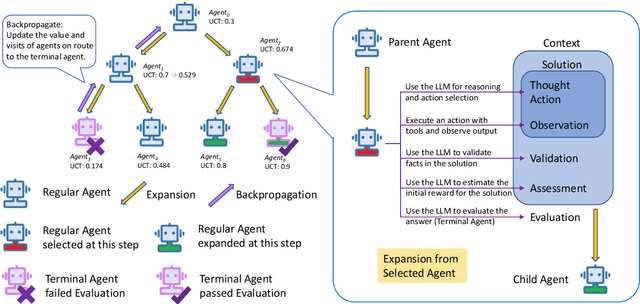
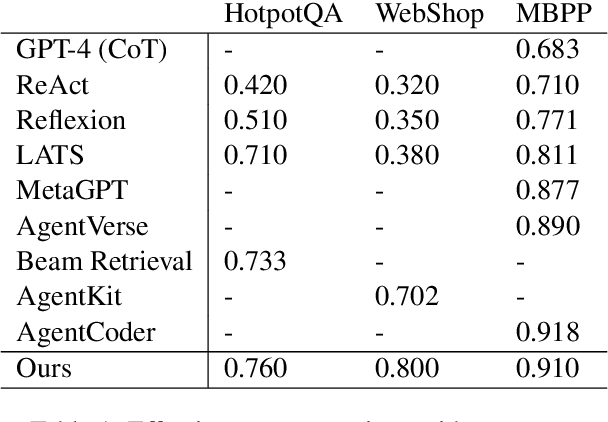

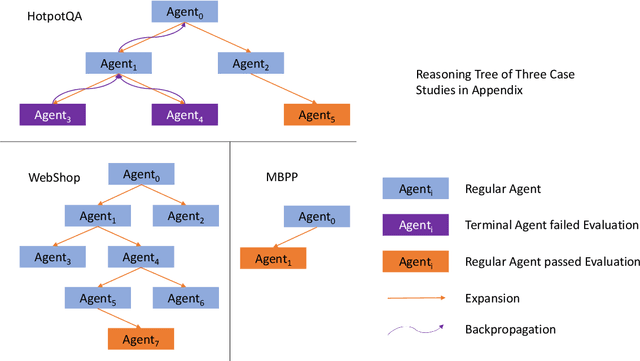
Abstract:Large Language Models (LLM) are increasingly being explored for problem-solving tasks. However, their strategic planning capability is often viewed with skepticism. Recent studies have incorporated the Monte Carlo Tree Search (MCTS) algorithm to augment the planning capacity of LLM. Despite its potential, MCTS relies on extensive sampling simulations to approximate the true reward distribution, leading to two primary issues. Firstly, MCTS is effective for tasks like the Game of Go, where simulation results can yield objective rewards (e.g., 1 for a win and 0 for a loss). However, for tasks such as question answering, the result of a simulation is the answer to the question, which cannot obtain an objective reward without the ground truth. Secondly, obtaining statistically significant reward estimations typically requires a sample size exceeding 30 simulations, resulting in excessive token usage and time consumption. To address these challenges, we present Multi-Agent System with Tactical Execution and Reasoning using LLM Specialized MCTS (MASTER), a novel framework that coordinates agent recruitment and communication using LLM specialized MCTS. This system autonomously adjusts the number of agents based on task complexity and ensures focused communication among them. Comprehensive experiments across various tasks demonstrate the effectiveness of our proposed framework. It achieves 76% accuracy on HotpotQA and 80% on WebShop, setting new state-of-the-art performance on these datasets.
PoseCrafter: One-Shot Personalized Video Synthesis Following Flexible Poses
May 23, 2024



Abstract:In this paper, we introduce PoseCrafter, a one-shot method for personalized video generation following the control of flexible poses. Built upon Stable Diffusion and ControlNet, we carefully design an inference process to produce high-quality videos without the corresponding ground-truth frames. First, we select an appropriate reference frame from the training video and invert it to initialize all latent variables for generation. Then, we insert the corresponding training pose into the target pose sequences to enhance faithfulness through a trained temporal attention module. Furthermore, to alleviate the face and hand degradation resulting from discrepancies between poses of training videos and inference poses, we implement simple latent editing through an affine transformation matrix involving facial and hand landmarks. Extensive experiments on several datasets demonstrate that PoseCrafter achieves superior results to baselines pre-trained on a vast collection of videos under 8 commonly used metrics. Besides, PoseCrafter can follow poses from different individuals or artificial edits and simultaneously retain the human identity in an open-domain training video.
EulerFormer: Sequential User Behavior Modeling with Complex Vector Attention
Apr 04, 2024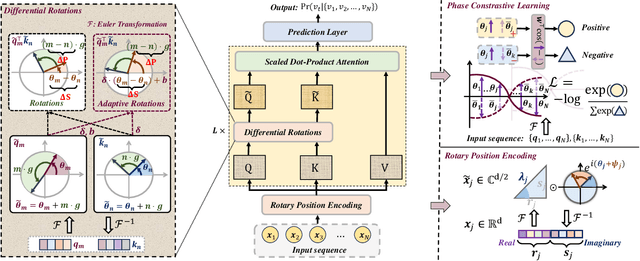


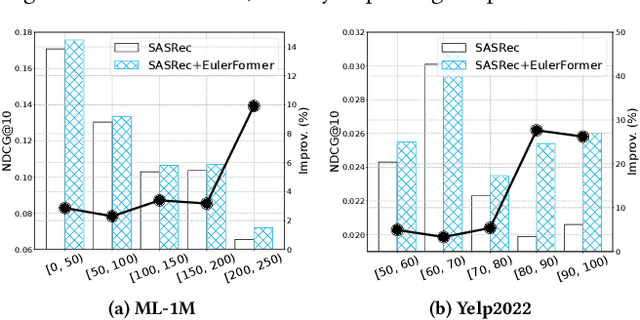
Abstract:To capture user preference, transformer models have been widely applied to model sequential user behavior data. The core of transformer architecture lies in the self-attention mechanism, which computes the pairwise attention scores in a sequence. Due to the permutation-equivariant nature, positional encoding is used to enhance the attention between token representations. In this setting, the pairwise attention scores can be derived by both semantic difference and positional difference. However, prior studies often model the two kinds of difference measurements in different ways, which potentially limits the expressive capacity of sequence modeling. To address this issue, this paper proposes a novel transformer variant with complex vector attention, named EulerFormer, which provides a unified theoretical framework to formulate both semantic difference and positional difference. The EulerFormer involves two key technical improvements. First, it employs a new transformation function for efficiently transforming the sequence tokens into polar-form complex vectors using Euler's formula, enabling the unified modeling of both semantic and positional information in a complex rotation form.Secondly, it develops a differential rotation mechanism, where the semantic rotation angles can be controlled by an adaptation function, enabling the adaptive integration of the semantic and positional information according to the semantic contexts.Furthermore, a phase contrastive learning task is proposed to improve the isotropy of contextual representations in EulerFormer. Our theoretical framework possesses a high degree of completeness and generality. It is more robust to semantic variations and possesses moresuperior theoretical properties in principle. Extensive experiments conducted on four public datasets demonstrate the effectiveness and efficiency of our approach.
 Add to Chrome
Add to Chrome Add to Firefox
Add to Firefox Add to Edge
Add to Edge